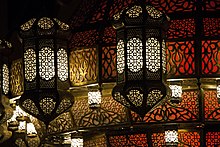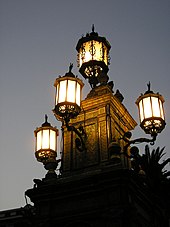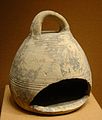Lantern

A lantern is a source of lighting, often portable. It typically features a protective enclosure for the light source – historically usually a candle, a wick in oil, or a thermoluminescent mesh, and often a battery-powered light in modern times – to make it easier to carry and hang up, and make it more reliable outdoors or in drafty interiors. Lanterns may also be used for signaling, as torches, or as general light-sources outdoors.
Uses
[edit]The lantern enclosure was primarily used to prevent a burning candle or wick being extinguished from wind, rain or other causes. Some antique lanterns have only a metal grid, indicating their function was to protect the candle or wick during transportation and avoid the excess heat from the top to avoid unexpected fires.
Another important function was to reduce the risk of fire should a spark leap from the flame or the light be dropped. This was especially important below deck on ships: a fire on a wooden ship was a major catastrophe. Use of unguarded lights was taken so seriously that obligatory use of lanterns, rather than unprotected flames, below decks was written into one of the few known remaining examples of a pirate code, on pain of severe punishment.[1]
Lanterns may also be used for signaling. In naval operations, ships used lights to communicate at least as far back as the Middle Ages;[2] the use of a lantern that blinks code to transmit a message dates to the mid-1800s.[3] In railroad operations, lanterns have multiple uses. Permanent lanterns on poles are used to signal trains about the operational status of the track ahead, sometimes with color gels in front of the light to signify stop, etc.[4] Historically, a flagman at a level crossing used a lantern to stop cars and other vehicular traffic before a train arrived.[5] Lanterns also provided a means to signal from train-to-train or from station-to-train.[6]
A "dark lantern" was a candle lantern with a sliding shutter so that a space could be conveniently made dark without extinguishing the candle. For example, in the Sherlock Holmes story "The Red-Headed League", the detective and police make their way down to a bank vault by lantern light but then put a 'screen over that dark lantern' in order to wait in the dark for thieves to finish tunneling.[7] This type of lantern could also preserve the light source for sudden use when needed.

Lanterns may be used in religious observances. In the Eastern Orthodox Church, lanterns are used in religious processions and liturgical entrances, usually coming before the processional cross. Lanterns are also used to transport the Holy Fire from the Church of the Holy Sepulchre on Great Saturday during Holy Week.
Lanterns are used in many Asian festivals. During the Ghost Festival, lotus shaped lanterns are set afloat in rivers and seas to symbolically guide the lost souls of forgotten ancestors to the afterlife. During the Lantern Festival, the displaying of many lanterns is still a common sight on the 15th day of the first lunar month throughout China. During other Chinese festivities, kongming lanterns (sky lanterns) can be seen floating high into the air. However, some jurisdictions, such as in Canada, some states in the U.S., and parts of India, as well as some organizations, ban the use of sky lanterns because of concerns about fire and safety.[8][9][10][11][12] [13]
The term "lantern" can be used more generically to mean a light source, or the enclosure for a light source, even if it is not portable. Decorative lanterns exist in a wide range of designs. Some hang from buildings, such as street lights enclosed in glass panes. Others are placed on or just above the ground; low-light varieties can function as decoration or landscape lighting and can be a variety of colors and sizes. The housing for the top lamp and lens section of a lighthouse may be called a lantern.[14]
Etymology
[edit]The word lantern comes via French[15] from Latin lanterna meaning "lamp, torch,"[16] possibly itself derived from Greek.[17]
An alternate historical spelling was "lanthorn", possibly derived from the ancient use of animal horn to cover window apertures, but allow in light. A lanthorn might have been significantly larger and brighter than a lantern.[18]
Construction
[edit]Lanterns were usually made from a metal frame with several sides (usually four, but up to eight) or round, commonly with a hook or a hoop of metal on top. Windows of some translucent material may be fitted in the sides; these are now usually glass or plastic but formerly were thin sheets of animal horn, or tinplate punched with holes or decorative patterns.
Paper lanterns are made in societies around the world.
A lantern generally contains a burning light source: a candle, liquid oil with a wick,[19] or gas with a mantle. The ancient Chinese sometimes captured fireflies in transparent or semi-transparent containers and used them as (short-term) lanterns, and use of fireflies in transparent containers was also a widespread practice in ancient India; however, since these were short-term solutions, the use of fire torches was more prevalent.[citation needed]
Modern varieties often place an electric light in a decorative glass case.
History
[edit]
In 1417, the Mayor of London ordered that all homes must hang lanterns outdoors after nightfall during the winter months. This marked the first organized public street lighting. [20]
Lanterns have been used functionally, for light rather than decoration, since antiquity.[19] Some used a wick in oil,[19] while others were essentially protected candle-holders. Before the development of glass sheets, animal horn scraped thin and flattened was used as the translucent window.
Beginning in the Middle Ages, middle eastern towns hired watchmen to patrol the streets at night, as a crime deterrent. Each watchman carried a lantern or oil lamp against the darkness.[21][page needed] The practice continued up through at least the 18th century.[22]
In March 1764 and twice in October 1764, George Allsopp, a British-born Canadian, was arrested in Quebec for violating an order to carry lanterns during the night.[23] There was violence every time he was arrested and Allsopp would denounce the military. In October he prosecuted the soldiers involved in his arrests.[23]
On April 18, 1775, Paul Revere had two lanterns held up in the Old North Church to signal to patriots in Charlestown that the British troops were crossing the Charles River to disarm the rebel colonial militias. The Battles of Lexington and Concord occurred the day after on April 19, starting the American Revolution.
Public spaces became increasingly lit with lanterns in the 1500s,[24] especially following the invention of lanterns with glass windows, which greatly improved the quantity of light. In 1588 the Parisian Parlement decreed that a torch be installed and lit at each intersection, and in 1594 the police changed this to lanterns.[25] Beginning in 1667 during the reign of King Louis XIV, thousands of street lights were installed in Parisian streets and intersections.[26] Under this system, streets were lit with lanterns suspended 20 yards (18 m) apart on a cord over the middle of the street at a height of 20 feet (6.1 m); as an English visitor described in 1698, 'The streets are lit all winter and even during the full moon!'[27] In London, a diarist wrote in 1712 that ‘All the way, quite through Hyde Park to the Queen's Palace at Kensington, lanterns were placed for illuminating the roads on dark nights.’[28]
Modern lanterns
[edit]Fueled lanterns
[edit]All fueled lanterns are somewhat hazardous owing to the danger of handling flammable and toxic fuel, danger of fire or burns from the high temperatures involved, and potential dangers from carbon monoxide poisoning if used in an enclosed environment.
Simple wick lanterns remain available. They are cheap and durable and usually can provide enough light for reading. They require periodic trimming of the wick and regular cleaning of soot from the inside of the glass chimney.
Mantle lanterns use a woven ceramic impregnated gas mantle to accept and re-radiate heat as visible light from a flame. The mantle does not burn (but the cloth matrix carrying the ceramic must be "burned out" with a match prior to its first use). When heated by the operating flame the mantle becomes incandescent and glows brightly. The heat may be provided by a gas, by kerosene, or by a pressurized liquid such as "white gas", which is essentially naphtha. For protection from the high temperatures produced and to stabilize the airflow, a cylindrical glass shield called the globe or chimney is placed around the mantle.
Manually pressurized lanterns using white gas (also marketed as Coleman fuel or "Camp Fuel") are manufactured by the Coleman Company in one and two-mantle models. Some models are dual fuel and can also use gasoline. These are being supplanted by a battery-powered fluorescent lamp and LED models, which are safer in the hands of young people and inside tents. Liquid fuel lanterns remain popular where the fuel is easily obtained and in common use.
Many portable mantle-type fuel lanterns now use fuel gases that become liquid when compressed, such as propane, either alone or combined with butane. Such lamps usually use a small disposable steel container to provide the fuel. The ability to refuel without liquid fuel handling increases safety. Additional fuel supplies for such lamps have an indefinite shelf life if the containers are protected from moisture (which can cause corrosion of the container) and excess heat.
Electric lanterns
[edit]
Lanterns designed as permanently mounted electric lighting fixtures are used in interior, landscape, and civic lighting applications. Styles can evoke former eras, unify street furniture themes, or enhance aesthetic considerations. They are manufactured for use with various wired voltage supplies.
Various battery types are used in portable light sources. They are more convenient, safer, and produce less heat than combustion lights. Solar-powered lanterns have become popular in developing countries, where they provide a safer and cheaper alternative to kerosene lamps.[29]
Lanterns utilizing LEDs are popular as they are more energy-efficient and rugged than other types, and prices of LEDs suitable for lighting have dropped.
Some rechargeable fluorescent lanterns may be plugged in at all times and may be set up to illuminate upon a power failure, a useful feature in some applications. During extensive power failures (or for remote use), supplemental recharging may be provided from an automobile's 12-volt electrical system or from a modest solar-powered charger.
Gallery
[edit]Hand-held lanterns
[edit]-
Iron ship lantern recovered from English carrack Mary Rose (16th century)
-
Lantern of metal and glass (Brazil, 19th century)
-
Miniature glass lamp (Brazil, 19th century)
-
Tin lantern, candle for light, with horn windows (Minnesota, USA, c. 1863)
-
Lamp on the Weka Pass Railway, New Zealand
-
Metal and glass lantern, (Brazil, 20th century)
-
Brass carbide burner trainman's lantern, (German Reich Railway, c. 1942)
-
Modern Chinese-made RE Dietz "Little Wizard No. 1" kerosene lantern
-
Two kerosene lanterns: mixed air on right and fresh air on left (Germany, 2010)
-
A fuel-burning Coleman lantern (England, 2012)
-
High-end LED lantern, powered by lithium-ion batteries, with modern features like a USB-C charging port and variable color temperature (2020)
Paper lanterns
[edit]-
A modern Kǒngmíng lantern (Chinese)
-
Yi Peng (Loi Krathong) festival in Tudongkasatan Lanna (Lanna Meditation Retreat Centre), Mae Jo Chiang Mai, Thailand
Exterior lighting
[edit]-
An electrically retrofitted lantern in use in rural Chhattisgarh, India
-
Palace lantern in the night sky of Lijiang, Yunnan, China
-
Lantern in Wuppertal, Germany
-
Station kerosene lamp at Rizhsky station railway museum, Moscow, Russia, 19th c.
In popular culture
[edit]The derived term "lantern jaw[ed]" is used in two quite different still current ways, comparing faces with different types of lantern. According to the Oxford English Dictionary, it refers to "long thin jaws, giving a hollow appearance to the cheek";[30] this use was recorded in 1361, referring to a lantern with concave horn sides before glass was in use. Another meaning of "lantern jaw" compares a lantern with a jutting base – such as the 15th-century example above – to the face of a person with the extended chin of mandibular prognathism;[31] this condition was also known as Habsburg jaw or Habsburg lip, as it was a hereditary feature of the House of Habsburg (see, for example, portraits of Charles V).
Raise the Red Lantern, a 1991 Chinese film, prominently features lanterns as a motif.
"The Tell-Tale Heart", a short story by Edgar Allan Poe, features the use of a dark lantern by the protagonist to shine a single ray of light on his victim's eye.
See also
[edit]References
[edit]- ^ Article VI of Captain John Phillips's articles.
- ^ Sterling, Christopher H., ed. (2008). Military Communications: From Ancient Times to the 21st Century. Santa Barbara, California: ABC-CLIO, Inc. p. 287. ISBN 978-1-85109-732-6.
Medieval ships, like the carrack and smaller caravel, used flag and lantern communication.
- ^ Sterling 2008, p. 209.
- ^ Lascelles, T. S. (1922). "Weissenbruch Three-Position Signal System as Used in Belgium: Four Indications Given, Clear, Caution, Attention or Stop". Railway Signal Engineer. 15 (2). Simmons-Boardman Publishing Company: 55–58.
- ^ Railway Signal Engineer: Fifteenth Volume, from January, 1922, to December, 1922, Simmons-Boardman Publishing Company, 1922, p. 178,
The News of the Month.... Sixteen persons were killed and nine injured at Painesville, Ohio, on the night of March 3, [1922,] when a New York Central express train, eastbound, crashed into a crowded motor bus at St. Clair street in that city. The railroad company issued a statement that the crossing watchman was on duty at the time and signaled the driver of the bus with his lantern to stop. The flagman states that he began to five the bus driver this warning signal when the latter was still from 300 to 500 ft. from the tracks, and the train had its electric headlight burning bright and clear; its whistle was sounded twice and the bell was ringing automatically. The bus driver was among the fatally injured.
- ^ "Antique Railroad Lanterns and Lamps". Collectors Weekly. Auctions Online USA Ltd. n.d. Retrieved 17 February 2020.
- ^ Doyle, Arthur Conan (1861), "The Red-Headed League", The Adventures of Sherlock Holmes
- ^ Boesveld, Sarah (23 July 2013). "While their popularity soars, illuminated paper lanterns increasingly banned across Canada as 'serious fire hazards'". National Post. Postmedia Network Inc.
- ^ Gabbert, Bill (31 December 2015). "Update on the legality of sky lanterns – banned in 29 states". Wildfire Today. Retrieved 17 February 2020.
- ^ Sky Lanterns Safety (PDF), Quincy, Massachusetts, USA: National Fire Protection Association, 2016
- ^ Barrett, Thomas (21 March 2018), "Feature: sky lanterns – safe or scourge?", Environment Journal
- ^ Banerjee, Tamaghna (31 October 2018). "Sky lantern ban extended to six PS area". The Times of India. Kolkata, India: Bennett, Coleman & Co. Ltd.
- ^ "Sky Lantern Dangers". Scouting.org. Boy Scouts of America. Retrieved 17 February 2020.
- ^ Pepper, Terry. "Great Lakes Lighthouse Illumination". Seeing the Light. Archived from the original on 23 January 2009. Retrieved 21 September 2008.
- ^ Wedgwood, Hensleigh (1855). "On False Etymologies". Transactions of the Philological Society (6): 66.
- ^ "lantern". www.etymonline.com. Online Etymology Dictionary. Retrieved 19 July 2019.
- ^ "lantern". Oxford English Dictionary (Online ed.). Oxford University Press. (Subscription or participating institution membership required.)
- ^ Basdeo, Stephen (17 May 2020). "The Difference between Lantern and Lanthorn". The Victorian Web. Retrieved 16 July 2024.
- ^ a b c "A rare Roman lantern (Ipswich)". Colchester and Ipswich Museums. Archived from the original on 16 May 2017. Retrieved 30 March 2018.
- ^ https://www.eaton.com/mx/en-us/company/news-insights/lighting-resource/trends/a-brief-history-of-street-lighting.html
- ^ Jovinelly, Joann; Netelkos, Jason (2007). The Crafts and Culture of a Medieval Town. New York, New York: The Rosen Publishing Group, Inc. ISBN 978-1-4042-0761-5.
- ^ Beattie, J.M. (2001). Policing and Punishment in London, 1660–1750: Urban Crime and the Limits of Terror. Great Britain: Oxford University Press. p. 181. ISBN 0-19-820867-7.
- ^ a b Roberts, David (1983). "Allsopp, George". In Halpenny, Francess G (ed.). Dictionary of Canadian Biography. Vol. V (1801–1820) (online ed.). University of Toronto Press. Retrieved 15 June 2022.
- ^ Schivelbusch, Wolfgang (1987). "The Policing of Street Lighting". Yale French Studies (73): 61–74. doi:10.2307/2930197. JSTOR 2930197.
- ^ Fierro 1996, pp. 835–836.
- ^ Tucker, Holly (22 March 2017), "How Paris Became the City of Light: Louis XIV hires the city's first police chief", Lapham's Quarterly, retrieved 17 February 2020
- ^ Fierro 1996, p. 837.
- ^ Millar, Preston S. (30 April 1920). "Historical Sketch of Street Lighting". Transactions of the Illuminating Engineering Society. XV (3). New York, New York: Illuminating Engineering Society: 185–202.
- ^ Wheldon, Anne (March 2006). "Affordable solar lanterns to replace kerosene lamps". Ashden Awards for sustainable energy. The Ashden Awards. Archived from the original on 15 July 2006.
- ^ "lantern jaw". Oxford English Dictionary (Online ed.). Oxford University Press. (Subscription or participating institution membership required.)
- ^ "Lantern jaw". Collins English Dictionary. Retrieved 16 March 2018.
Bibliography
[edit]- Fierro, Alfred (1996). Histoire et dictionnaire de Paris (in French). Lafont. ISBN 978-0-7859-9300-1.
- Needham, Joseph (1985). Science and Civilisation in China: Paper and Printing. Cambridge University Press. ISBN 978-0-521-08690-5.






















